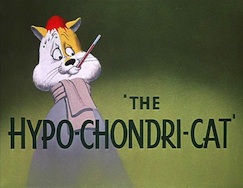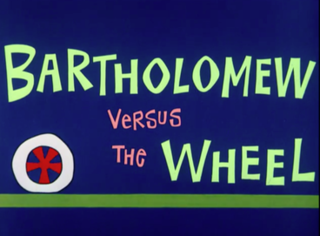Related Research Articles

Hippety Hopper is a young kangaroo character in the Warner Bros. Looney Tunes series of cartoons. Robert McKimson introduced Hippety Hopper in Hop, Look and Listen (1948), which established the pattern for future Hippety Hopper cartoons. The character appeared in 14 theatrical cartoons between 1948 and 1964.

Scaredy Cat is a 1948 Warner Bros. Merrie Melodies cartoon directed by Chuck Jones. The short was released on December 18, 1948, and stars Porky Pig and Sylvester the Cat. The cartoon is notable in that it marks the first time the name "Sylvester" is used for the popular feline character. In previous shorts, the cat is unnamed, except for in the 1947 cartoon Tweetie Pie in which he is referred to as "Thomas".

Cool Cat is a fictional cartoon character created by director Alex Lovy for Warner Bros.-Seven Arts Animation. He was the final star of the original Warner Bros. theatrical cartoons. His first appearance was in an eponymous short in 1967. He was voiced by Larry Storch. Robert McKimson took over as director for the last two cartoons in this series.

Babbit and Catstello are fictional characters, based on the comedic duo Abbott and Costello, that appeared in Warner Bros. animated cartoons. The characters appeared in four cartoons between 1942 and 1946: once as cats, once as dogs, and twice as mice.

An Itch in Time is a 1943 Warner Bros. Merrie Melodies cartoon, directed by Bob Clampett. The short was released on December 4, 1943 and features Elmer Fudd, with a dog and cat that look similar to Willoughby and Claude Cat.

Walky Talky Hawky is a 1946 Warner Bros. Merrie Melodies theatrical short directed by Robert McKimson. The cartoon was released on August 31, 1946, and features Henery Hawk and Foghorn Leghorn. This is the first appearance of both Foghorn Leghorn and the Barnyard Dawg.
Tabasco Road is a 1957 Warner Bros. Looney Tunes cartoon directed by Bob McKimson. The short was released on July 20, 1957, and stars Speedy Gonzales.

The Foghorn Leghorn is a 1948 Warner Bros. Merrie Melodies cartoon directed by Robert McKimson. The cartoon was released on October 9, 1948, and features Foghorn Leghorn, Henery Hawk and the Barnyard Dawg.
Cheese It, the Cat! is a 1957 Warner Bros. Looney Tunes cartoon, directed by Robert McKimson. The short was released on May 4, 1957, and is the second of three McKimson cartoons parodying television's The Honeymooners.
This is a listing of all the animated shorts released by Warner Bros. under the Looney Tunes and Merrie Melodies banners between 1960 and 1969. A total of 147 shorts were released during the 1960s.

The Mouse That Jack Built is a 1959 Warner Bros. Merrie Melodie cartoon short starring Jack Benny and the regular cast of The Jack Benny Program as mice. The short, released on April 4, 1959, was written by Tedd Pierce and directed by Robert McKimson.
A Bird in a Bonnet is a 1958 Warner Bros. Merrie Melodies animated short directed by Friz Freleng. The voices were performed by Mel Blanc, Daws Butler and June Foray. The short was released on September 27, 1958, and stars Tweety and Sylvester.

Mouse Wreckers is a 1949 Warner Bros. Looney Tunes short directed by Chuck Jones, written by Michael Maltese and starring Hubie and Bertie in their first pairing with the redesigned Claude Cat. The cartoon was released on April 23, 1949.

The Hypo-Chondri-Cat is a 1950 Warner Bros. Merrie Melodies short directed by Chuck Jones and written by Michael Maltese. The cartoon was released on April 15, 1950 and stars Hubie and Bertie and Claude Cat. The title is a play on "hypochondriac".
Trap Happy Porky is a 1945 Warner Bros. Looney Tunes short directed by Chuck Jones and written by Tedd Pierce. The short was released on February 24, 1945, and features Porky Pig, along with Hubie and Bertie, an early version of Claude Cat and a prototype of Hector the Bulldog.

Odor-able Kitty is a 1945 Warner Bros. Looney Tunes cartoon directed by Chuck Jones. The short was released on January 6, 1945, and was the first appearance of the romantic skunk Pepé Le Pew.
Mouse-Warming is a 1952 Warner Bros. Looney Tunes short, directed by Chuck Jones. The cartoon was released on September 6, 1952 and stars Claude Cat in his final solo cartoon.

Bartholomew Versus the Wheel is a 1964 Warner Bros. Merrie Melodies cartoon directed by Robert McKimson. It was released theatrically on February 29, 1964.
Mexican Mousepiece is a 1966 Warner Bros. Merrie Melodies cartoon directed by Robert McKimson. The short was released on February 26, 1966, and stars Daffy Duck and Speedy Gonzales.

It's Hummer Time is a 1950 Warner Bros. Looney Tunes cartoon directed by Robert McKimson and written by Warren Foster. The short was released on July 22, 1950. The cartoon stars a tuxedo cat who attempts to catch a hummingbird, only to get in the way of a bulldog who subjects him to various forms of torture for accidentally hurting and bugging him while doing so to the tune of Raymond Scott's Powerhouse, the cat seeming to know what's in store for him each time. All voice characterizations are performed by Mel Blanc.
References
- ↑ Beck, Jerry; Friedwald, Will (1989). Looney Tunes and Merrie Melodies: A Complete Illustrated Guide to the Warner Bros. Cartoons. Henry Holt and Co. p. 326. ISBN 0-8050-0894-2.
- ↑ Lenburg, Jeff (1999). The Encyclopedia of Animated Cartoons. Checkmark Books. p. 93. ISBN 0-8160-3831-7 . Retrieved 6 June 2020.